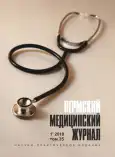Efficacy of using virtual reality in post-stroke upper limb paresis
- Authors: Dolganov M.V.1, Karpova M.I.1
-
Affiliations:
- South-Ural State Medical University
- Issue: Vol 35, No 1 (2018)
- Pages: 60-67
- Section: Articles
- URL: https://journals.rcsi.science/PMJ/article/view/8671
- DOI: https://doi.org/10.17816/pmj35160-67
- ID: 8671
Cite item
Full Text
Abstract
Aim. To estimate the efficacy of using training by means of virtual reality in restoration of the upper limb function in patients during the acute period of stroke.
Materials and methods. 48 patients in the acute period of stroke (average time from the onset of stroke 4.5 ± 1.3 days, mean age 67 (45; 72.1) years were randomized into 2 groups: the main group (standard therapy + virtual reality) and the control (standard therapy alone). Patients of the main group underwent a course of virtual reality training, lasting for 15 minutes, twice a day for 10 days. The functional status before the onset of training course and after it was evaluated using Fugl-Meyer Assessment Scores (FMA), Motor Assessment Scale (MAS), Ashworth Scale, Modified Barthel Index Score (MBI), Action Research Arm Test (ARAT), 9-Hole Peg Test, Rankin Scale, Function Independence Measure (FIM) and dynamometry.
Results. When assessing FMA of “upper limb” (p = 0.029), “wrist” (p = 0.04), “hand speed” (p = 0.02); MAS (p = 0.042), 9-Hole Peg Test (p = 0.028), paretic hand dynamometry (p = 0.03) and FIM (p = 0.045), patients of the main group demonstrated statistically significant improvement versus the control group.
Conclusions. The results detected that inclusion of a short training course, using virtual reality, improves the upper limb function in patients during the acute period of stroke.
Keywords
Full Text
##article.viewOnOriginalSite##About the authors
M. V. Dolganov
South-Ural State Medical University
Author for correspondence.
Email: michail1_dolganov@mail.ru
ассистент кафедры нервных болезней
Russian Federation, 64, Vorovsky street, Chelyabinsk, 454092M. I. Karpova
South-Ural State Medical University
Email: michail1_dolganov@mail.ru
доктор медицинских наук, доцент, заведующая кафедрой нервных болезней
Russian Federation, 64, Vorovsky street, Chelyabinsk, 454092References
- Байдина Т.В., Исакова Н.В., Невоструева О.Н. Динамика постинсультной астении в процессе восстановительного лечения. Вопросы курортологии, физиотерапии и лечебной физической культуры 2004; 6: 15.
- Заболеваемость взрослого населения России в 2015 году. Статистические материалы. Министерство здравоохранения Российской Федерации, Департамент мониторинга анализа и стратегического развития здравоохранения, ФГБУ «Центральный научно-исследовательский институт организации и информатизации здравоохранения» Минздрава России. М. 2016; Ч. III.
- Каракулова Ю.В., Селянина Н.В., Желнин А.В., Филимонова Т.А., Цепилов С.В. Влияние антиоксидантной терапии на нейротрофины и процессы реабилитации после инсульта. Журнал неврологии и психиатрии им. С.С. Корсакова 2016; 8: 36–39.
- Новикова Л.Б., Акопян А.П., Шарапова К.М., Минибаева Г.М. Реабилитация двигательных функций у больных, перенесших церебральный инсульт, с использованием роботизированного комплекса Lokomat. Физиотерапия, бальнеология и реабилитация 2013; 5: 50–51.
- Хижникова А.Е., Клочков А.С., Котов-Смоленский А.М., Супонева Н.А., Черникова Л.А. Виртуальная реальность как метод восстановления двигательной функции руки. Анналы неврологии 2016; 3: 5–12.
- Foreman N., Korallo L. Past and future applications of 3-D (virtual reality) technology. Scientific and Technical Journal of Information Technologies, Mechanics and Optics 2014; 94: 1–7.
- Ji E.K., Lee S.H. Effects of virtual reality training with modified constraint-induced movement therapy on upper extremity function in acute stage stroke: a preliminary study. J Phys Ther Sci 2016; 28 (11): 3168–3172.
- Jonassen D. Handbook of research on educational communications and technology. 2nd ed. Lawrence Erlbaum Associates Inc., Publishers 2004: 461–498.
- Hatem S.M., Saussez G., Della Faille M., Prist V., Zhang X., Dispa D., Bleyenheuft Y. Rehabilitation of motor function after stroke: a multiple systematic review focused on techniques to stimulate upper extremity recovery. Frontiers in human neuroscience 2016; 10: 442.
- Laver K., George S., Thomas S., De utsch J.E., Crotty M. Virtual reality for stroke rehabilitation: an abridged version of a Cochrane review. Eur J Phys Rehabil Med 2015; 51: 497–506.
- Patel J., Qiu Q., Yarossi M., Merians A., Massood S., Tunik E., Adamovich S., Fluet G. Exploring the impact of visual and movement based priming on a motor intervention in the acute phase post-stroke in persons with severe hemiparesis of the upper extremity. Disabil Rehabil 2017; 39 (15): 1515–1523.
- Samuel G.S., Oey N.E., Choo M., Ju H., Chan W.Y., Kok S., Ge Y., Van Dongen A.M., Ng Y.S. Combining levodopa and virtual reality-based therapy for the rehabilitation of upper limb after acute stroke: pilot study part II. Singapore Med J 2016; 1025.
- Veerbeek J.M., E. van Wegen, R. van Peppen, P.J. van der Wees, Hendriks E., Rietberg M., Kwakkel G. What is the evidence for physical therapy poststroke? A systematic review and meta-analysis. PLoS One 2014. 9: e87987.
Supplementary files






